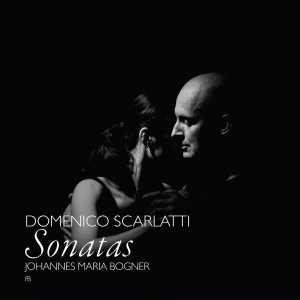Johannes Maria Bogner
Clavichord
by Thomas Vincent Glück after Bartolomeo Cristofori
Domenico Scarlatti (1685 – 1757)
[ 1 ] Sonata in A-Dur, K. 208 03 : 56
[ 2 ] Sonata in A-Dur, K. 209 04 : 57
[ 3 ] Sonata in f-moll, K. 238 03 : 40
[ 4 ] Sonata in f-moll, K. 239 03 : 36
[ 5 ] Sonata in C-Dur, Pastorale, K. 513 06 : 02
[ 6 ] Sonata in d-moll, Aria, K. 32 02 : 42
[ 7 ] Sonata in d-moll, K. 141 04 : 24
[ 8 ] Sonata in f-moll, K. 185 04 : 46
[ 9 ] Sonata in f-moll, K. 184 04 : 31
[ 10 ] Sonata in D-Dur, K. 119 07 : 10
[ 11 ] Sonata in g-moll, Fuga K. 30 04 : 50
[ 12 ] Sonata in Es-Dur, K. 193 04 : 31
[ 13 ] Sonata in C-Dur, K. 132 08 : 40
[ 14 ] Sonata in C-Dur, K. 133 04 : 43
[ 15 ] Sonata in a-moll, K. 175 04 : 42
Domenico Scarlatti, Dancing on the Keys
«In the light of his later music, it is by no means difficult to imagine Domenico Scarlatti strolling under the Moorish arcades of the Alcazar or listening at night in the streets of Seville to the intoxicating rhythms of castanets and the half oriental melodies of Andalusian chant. To them Saracen of his Sicilian ancestry and Neapolitan childhood must have responded.» (Ralph Kirkpatrick, Domenico Scarlatti)
Domenico Scarlatti was born in Naples and received his musical education from his father, Alessandro. He ended up working at the Spanish court, as a kind of satellite of Italian origins abandoned on the Iberian Peninsula at the end of the 17th century …
The impressions of Spanish folklore must have overwhelmed him there.
After four years in Seville, then Madrid. Oriental influences were rife in the former city, spreading throughout the country from the streets of Gibraltar. He would probably preferred to spend evenings around campfires of itinerant Moors than following etiquette at court …
All kinds of lute and guitar-like instruments could be heard there as well as wild castanet rhythms. These marked Scarlatti’s musical language.
A selection of sonatas reflecting this spirit and inventiveness, including many melodic traits of Arabic inspiration (with their typical augmented second intervals) is proposed here on the clavichord.
The endless tonal flexibility of the clavichord underlines the origins of this music, particularly on the instrument by Thomas Vincent Glück. Thanks to the elaborate construction in the bass, the powerful chords really come into their own with an almost unheard-of resonance…
A later contemporary witness noted the following testimony: «Scarlatti often said that he knew very well that he broke all rules of composition in his keyboard music, that there were almost no other rules a man of genius must follow other than this one, not to displease the only sense whose subject matter is music. Since nature had given him ten fingers, he saw no reason for not making use of all ten!»
(Wikipedia, Domenico Scarlatti)
He ignored every rule of traditional composition in order to achieve the effect his music should have; the number of voices changes arbitrarily, parallel octaves and fifths abound, all according to the vigorous, elemental force of his inspiration.
Domenico Scarlatti, the Clavichord and Bartolomeo Cristofori …
It is very likely that Domenico Scarlatti met Bartolomeo Cristofori in person in Florence on his travels in Italy with his father Alessandro at the start of the 18th century.
It was the most exciting time for the development of keyboard instrument building, just as Cristofori completed his first Cembalo col piano e forte in 1709. Scarlatti’s future employer, Maria Barbara of Spain, owned no less than five fortepianos of Florentine design. They were all built by pupils of Cristofori. The fascination of being able to play a keyboard which was touch-sensitive was the ultimate kick which subsequently marked the development of musical history over many decades. This feature is inherent in the clavichord’s construction, despite its being at least as old as its more inflexible brother, the harpsichord.
There is as little evidence of Scarlatti playing Cristofoi clavichords as there is for a meeting of the two spirits of the time, neither of whom could be outdone for love of experimentation. Both are likely, however, and such an exchange must have been of a special, inspiring explosive nature.
Clavichords were omnipresent both in Italy during Scarlatti’s youth and in Spain, where this instrument had a long tradition.
Johannes M. Bogner


